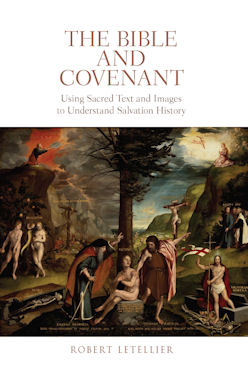
|
Posted November 5, 2013
Book: The Bible and Covenant: Using Sacred Text and Images to Understand Salvation History Author: Robert Letellier St. Pauls. Staten Island, NY. 2013. Pp. 173 An Excerpt from the Jacket:
Covenant is a term central to the whole of Scripture in which all the Bible finds its clarity. This work shows the reader the relationship between God's first covenants in the Old Testament and the new covenant sealed in the blood of Christ. No covenant is ever replaced, but rather all are fulfilled in Jesus who is the covenant personified. This key concept has enormous implications for the way Scripture is read and interpreted. It touches on two of the key issues that have helped to shape the nature of the Church, and continue to affect the witness and perception of the Catholic Church in the world. The first is the relationship with the Jewish People, our spiritual ancestors and first brothers and sisters in faith. The second is the tragic divisions within Christianity and the more serious doctrinal division in the Western Church. Both of these can be addressed in the wonderful covenant of God's saving power. In his commentary on the Second Vatican Council's document Nostra Aetate, the then Cardinal Ratzinger presented a lucid summary of the central theological issues arising out of the covenant shared by Jews and Christians alike insisting that the Abrahamic and Christian covenants represent a single movement of God in his work of reconciling humankind. He showed how the work of Christ was and is the fulfillment of God's promise announced in the covenant with Abraham. "All the nations of the world shall be blessed through you." This work is an in-depth study of this thesis. An Excerpt from the Book: Marriage And Tobias began to pray, "Blessed are you O God of our fathers, and blessed be your holy and glorious name for ever. Let the heavens and all your creatures bless you. You made Adam and gave him Eve his wife as a helper and support. From them the race of mankind has sprung. You did say, 'It is not good that the man should be alone; let us make a helper for him like himself.' And now, O Lord, I am not taking this sister of mine because of desire, but with sincerity. Grant that I may find mercy and may grow old together with here." And she said with him, "Amen." Marriage is part of the creative order and is one of those institutions that has been raised to a sacrament. The mutual consent of a man and woman is the ordinary matter that in the sacrament proclaims and celebrates something much deeper to the world. The man and the woman effectively become the ongoing sacrament for one another, and the Church enshrining the natural law, sanctifies this state of life. Building on the Jewish practice, the Church teaches that a marriage covenant or bond mirrors the covenant between God and his People, or Jesus and his Bride, the body of believers, or the Church who become his body. Marriage is called to be a prophetic sign of God's saving love, his steadfastness and faithfulness. This extraordinary sacrament is lived out in the everyday mundane aspects of life. The sacramental nature of marriage demonstrates that the reign of Christ extends to all that is human. The key to the understanding of the raising of marriage to a sacrament in the New Covenant that Jesus came to bring. The Old Testament gives an unwavering picture of nuptial fidelity. Hosea the prophet [=God] remains faithful and loving towards his unfaithful wife [=Israel/the Church]. The Song of Songs prefigures the New Covenant and uses the confirmation image of the seal: "Set me as a seal upon your heart, like a seal upon your arm. For love is as strong as death, jealousy as relentless as Sheol." The Patriarchs and Matriarchs (Abraham and Sarah, Isaac and Rebecca, Jacob and Rachel), later during the Exile Tobias and Sarah, and then eventually Joseph and Mary --- all display fidelity to God and to each other. In the New Covenant Paul explicitly associates marriage with Christ and the Church. "Husbands, love your wives as Christ loved the church and gave himself up for her." Paul explicitly refers to Adam's love at the beginning of creation: "For this shall cause a man to leave his father and mother and cleave to his wife, and the two shall become one flesh." He develops this in his own uniquely theological way: "This is a great sacrament; but I speak of Christ and the church." Table of Covenant Covenant And The Old Testament 1. Creation and fall--- Israel and the world 2. The birth of Israel 3. Israel freed from Egypt and in the wilderness 4. The unfortunate necessity of government: Israel and the Monarchy 5. Politics and the crisis of Israel Covenant And The New Testament 6. The covenant and eschatology: the concepts of the Kingdom of God, Messiah, Day of the Lord 7. The covenant and Christology: God's servant the anointed Son of David, the Son of Man, fulfilled in the New Covenant --- the Good News of Jesus Christ 8. The covenant and soteriology: the Old and New defined --- the epistles of Paul, and the theology of salvation. 9. The covenants and the sacraments: an invitation and a sign of grace and love in our daily lives. 10. The covenant and ecclesiology: the concept of the People of God 11. The covenant and moral theology/canon law: the concept of righteousness and justice in the life of the church |
|
